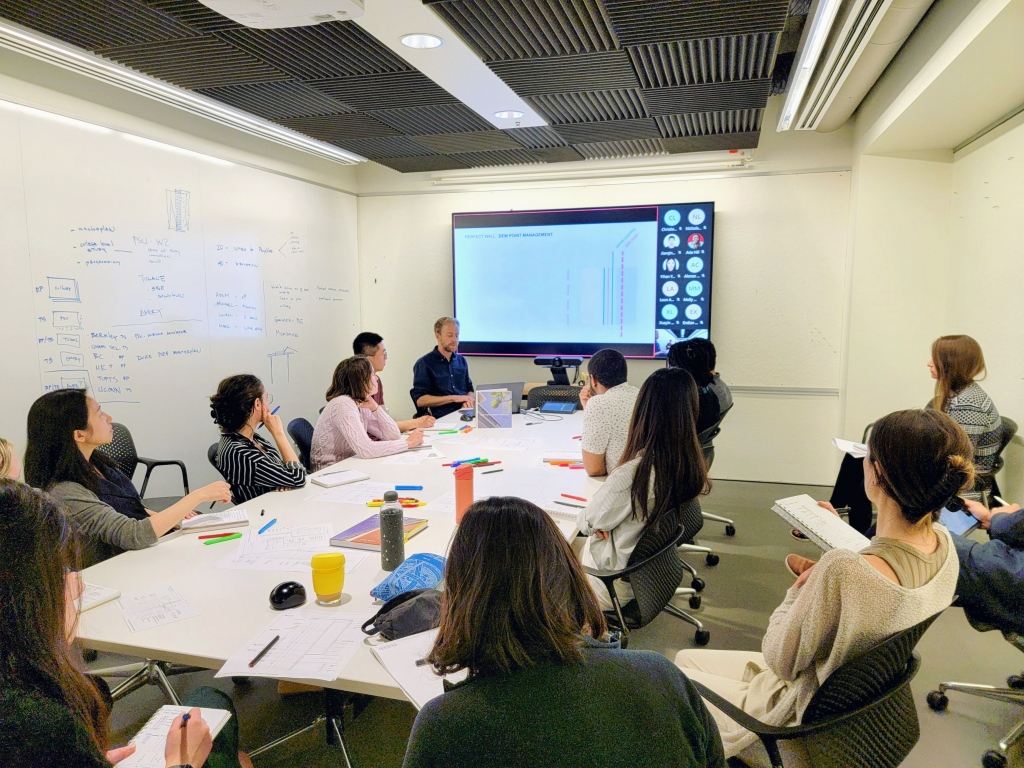PAYETTE’s Detail Dive Group recently hosted its second knowledge-sharing workshop, which delved into the control layers of a building’s envelope system. Tom Beresford and Jensen Ying led a group of young designers and architects through the fundamental principles of high-performance envelopes. Drawing references from John Straube’s work in “High Performance Enclosures”[1] and Joseph Lstiburek’s publication, “The Perfect Wall“[2] released by the Building Science Corporation, the workshop content introduced the group to essential concepts such as dew point and dew point curves, thermal bridging, the perfect wall system and a hands-on exercise in identifying control layers with an awareness of dew point and dew point curves, thermal bridging and the perfect wall/roof/slab. Below is a summary of the terminology and concepts discussed during this session.

Key Control Layers
There are five key control layers within a building envelope: bulk water (rain), thermal, water, air and vapor control layers. These layers hold significant importance for designers when designing and detailing an exterior envelope. Consideration should be given to factors such as continuity, code compliance, material compatibility, durability and appropriate application.
Dew Point & Dew Point Curve
In basic terms, the dew point can be understood as the temperature at which moisture in the air begins to condense (when relative humidity reaches 100%). The dew point curve indicates the position where condensation will take place. The precise location of condensation within an exterior wall assembly is crucial for water management, building performance, longevity of construction, infection control, indoor air quality and many other factors.
The Perfect Wall (The Works Everywhere Wall, the insitutional wall, the 500-year wall)
The Perfect Wall represents an exterior envelope assembly that is suitable for application in all climate zones. The assembly begins with the rainwater control layer, typically a cladding system supported by a thermally-broken/isolated subgirt system separate from the backing wall. The primary purpose of this layer is to protect the building from bulk water and ultraviolet radiation. Beyond the cladding layer, there is an air gap utilized for pressure equalization and drying. Next is the insulation layer, often comprised of a hydrophobic material like mineral wool, which is held in place by a girt system or fastened. The continuity and thermal resistance of the insulation are critical factors determining the location of the dew point curve.
Located inboard from the insulation layer are the continuous control layers for water, air and vapor. It is essential to differentiate between a water and air barrier versus a water, air and vapor barrier (often abbreviated AVB). Water and air barriers permit the passage of vapor (which is smaller than air and liquid water) in environments with high to low vapor pressure. These three control layers are often integrated into a single manufactured product that adheres to an acceptable substrate. With this assembly, the dew point curve is intentionally designed to outboard of beyond the three control layers.
an excersise in identifying control layers
The concluding part of the session involved attendees identifying the control layers in existing details. Prints of existing PAYETTE exterior details were utilized for this exercise. Using colored pens and highlighters, attendees identified the five types of control layers within the details. Following the completion of the exercise, the instructors reviewed the details with the attendees and addressed any remaining questions.

Conclusion
High-performance envelopes play a crucial role in the projects designed by PAYETTE. This introductory exploration of detailing building envelopes is fundamental to the firm’s ability to create long-lasting and high-performing buildings. The Detail Dive Group serves as an internal knowledge-sharing initiative, aiming to inspire and engage young designers and architects in the art of detailing and design.
[1] Straube, J. F. . (2012). High Performance Enclosures: Design Guide for Institutional Commercial and Industrial Buildings in Cold Climates. Building Science Press, Somerville, Massachusetts.
[2] Lstiburek, J. (2010, July 15). The Perfect Wall. BSI-001: The perfect wall. https://buildingscience.com/documents/insights/bsi-001-the-perfect-wall


